- Register
- Log in to Tune-In
- Wishlist (0)
-
Shopping cart
(0)
You have no items in your shopping cart.
Beatles News
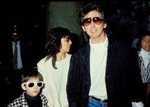
George Harrison‘s son, Dhani, grew up around a lot of good music; it was unavoidable. From Dhani’s perspective, though, his life was ordinary. He thought his father “pushed buttons for a living” and had no idea George helped make Yellow Submarine.
Eventually, Dhani learned about his famous father. George kept Dhani out of the spotlight because he wanted his son to have a good childhood, unlike some musicians’ children.
Once Dhani knew about his past and fame, though, George never pushed music on him or tried to get him to follow in his footsteps. That choice was up to Dhani. He took a long time to decide.'
Source: Hannah Wigandt /CheatSheat
details
The wife of late Beatles lead guitarist George Harrison has expressed joy about her return to Liverpool as she hopes to show a new side of him to fans.
Olivia married George - famed for penning the likes of Here Comes the Sun for the Fab Four - in 1978, and was with him until his death in 2001. Her collection of poems, Came the Lightening, was published last month (November 2022) but has been years in the making.
Olivia told the ECHO she started writing in "2018 or 2019", but when 2021 came around - two decades on from George's death - she realised she could release a collection with one poem for each year without him.
Source: Storm Newton/liverpoolecho.co.uk
details
George Harrison once revealed which of his songs he liked best that everyone else overlooked. The former Beatle tended to like the songs that didn’t do well on the charts.
In his 1980 memoir, I Me Mine, George wrote that writing songs stemmed from something deeper in someone like him who was born during a war. If you get all the persecution of being born in war, vibrations making you wonder what it’s all about, “you can see where it all comes out. I mean in your dreams.
“So it’s the unwinding of your nervous system,” George wrote. “The corresponding experience to what winds you up comes out in your dreams. To write a song then, even one like ‘Don’t Bother Me,’ helps to get rid of some subconscious burden.
Source: Hannah Wigandt/cheatsheet.com
details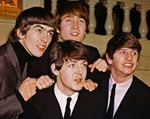
At the height of Beatlemania, everyone was getting The Beatles’ mop top haircut. The same thing happened to a lesser extent when George Clooney rocked the Caesar in the ‘90s. The Beatles’ do came from an outside source. Original “Fifth Beatle” Stuart Sutcliffe’s fiance, Astrid Kirchherr did the mop top. Here’s how John Lennon, Paul McCartney, George Harrison and former drummer Pete Best adopted the style.
Beatles historian David Bedford appeared on the Beatles City podcast on Aug. 23, 2020 to talk about Sutcliffe. Bedford was also in charge of Sutcliffe’s fan club. He explained how Sutcliffe’s hairdo, from Kirchherr, became the signature Beatles style.
Astrid Kirchherr gave Stuart Sutcliffe the first Beatles mop top
Sutcliffe was The Beatles’ first bass player. While performing with the band, he met Kirchherr. Their connection was intense and immediate.
Source: Fred Topel/cheatsheet.com
details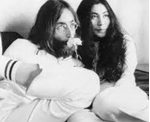
John Lennon said one song turned the Plastic Ono Band into The Beatles. He said people undervalued Yoko Ono’s role in the Plastic Ono Band. He discussed how people reacted to the group after one of their songs became a huge hit.
John Lennon said people dismissed the Plastic Ono Band when they released their first song, “Give Peace a Chance.” Subsequently, he said another song transformed the Plastic Ono Band into The Beatles. The track in question was an international hit.
The book Lennon on Lennon: Conversations with John Lennon includes an interview from 1975. In it, John compared Wings to the Plastic Ono Band. “Wings is almost as conceptual a group as Plastic Ono Band,” he said.
“Plastic Ono was a conceptual group, meaning whoever was playing was the band,” he added. “And Wings keeps changing all the time. It’s conceptual. I mean, they’re backup men for Paul.”
Source: Matthew Trzcinski/cheatsheet.com
details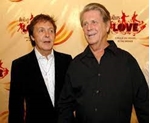
The Beach Boys and the Beatles were often inspired by one another — with Brian Wilson noting similarities between “Girl Don’t Tell Me” and John Lennon’s songwriting. Here’s what we learned from the memoir I Am Brian Wilson.
He’s one of the masterminds behind “God Only Knows,” “I Get Around,” and “Wouldn’t It Be Nice.” Aside from his role in the Beach Boys, Brian Wilson often shared his support for other bands. That includes the Beatles, who rose in popularity around the same time.
In his memoir, Wilson noted that the Beach Boys weren’t creating music “in a vacuum.” As they became popular, the group noticed the rise of rock and roll. They also noted the bands that impacted the music scene.
“One of the most important parts of the takeover was the Beatles,” Wilson wrote. The Beatles even impacted the Beach Boys’ original music — inspiring specific sounds and harmonies.
“I wrote a song called ‘Girl Don’t Tell Me,’” Wilson said in I Am Brian Wilson. “It was one of the first songs that Carl sang lead on, and one of the details

Paul McCartney has a musical gift that he displayed at a very young age. He learned how to play the piano and the guitar and formed The Beatles before many people even went to college. However, Paul McCartney didn’t achieve the same success as his other musical endeavors when he auditioned to become a choir boy and got rejected.
Paul McCartney’s Liverpool Oratorio is a live album by Paul McCartney and Carl Davis, released in 1991. Davis and McCartney composed the show to commemorate the Royal Liverpool Philharmonic Orchestra’s 150th anniversary. The album was recorded and performed at the Liverpool cathedral during the show’s dress rehearsal. In an interview with Barnes and Noble’s James Daunt, McCartney shared how this project originated.
“I knew Carl Davis, the composer and conductor, and his wife Jean, and Linda knew Jean. So he turned up one day and he said, ‘The Liverpool Philharmonic is having a big anniversary.’ I think it was 150 years,” McCartney said. “And he said, ‘And they’d like to commission you to write something.’ So I said, ‘Well, great.’ I had no idea what I was doing, but that’s me. details

Allan Kozinn and Adrian Sinclair's "The McCartney Legacy: Volume 1, 1969-73" is a triumph. Masterful in scope and full of rich detail, the first volume on Paul McCartney's post-Beatles career, out Tuesday from Dey Street Books, kicks off the authors' ambitious literary biography series in fine style.
Over the years, Paul McCartney has been the subject of numerous biographical studies, while remaining frustratingly elusive in terms of sharing the nature of his interior life. Kozinn and Sinclair sagely begin their book with an epigraph in which McCartney himself gets to the heart of the matter. "I'm very good at forgetting who I am," he admits, "because as far as I'm concerned Paul McCartney is a name I was given at birth, and at the beginning of the Beatles he split off into a celebrity, and I remained [as me]. . . . When you talk about Paul McCartney, I talk about the guy inside me, but you're talking about him—the guy who goes onstage and makes records and stuff."
Source: Kenneth Womack/salon.com
details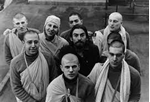
George Harrison freaked out some nuns who lived in his estate, Friar Park, before him. The former Beatle should’ve waited until all the nuns were moved out of the 35-acre property before he made it his own.
In the mid-1960s, George purchased a bungalow, Kinfauns, in Surrey. The home should’ve offered George the privacy he craved after living in London amid Beatlemania. However, it didn’t.
George said some fans knew where he lived, especially the students of an all-girls school down the road. He couldn’t have chosen a property with worse surroundings.
“Actually there’s a girls’ school right next to it but the head mistress was good and she told the kids to give me a bit of privacy,” George said.
Still, other fans found the property. There’s a video of some fans getting their autographs signed by George right on his front porch. Once, George and his wife, Pattie Boyd, came home to find two fans had broken in and were hiding under their bed.
In 1970, George needed more privacy.
Source: Hannah Wigandt/cheatsheet.com

It’s been 42 years since the tragic passing of John Lennon on December 8, 1980. Although it’s been decades since he was ruthlessly murdered on his own doorstep, Mary McCartney spoke EXCLUSIVELY with HollywoodLife and recalled how her father Sir Paul McCartney reacted to the passing of his former Beatles bandmate.
Mary McCartney’s first feature-length documentary ‘If These Walls Could Sing’ premieres on Disney+ on December 16 (Mercury Studios/Tim Cragg)
“I think it devastated him and it was a shock because John Lennon was somebody that advocated so strongly for peace,” the photographer and chef said while promoting her upcoming first feature-length documentary, If These Walls Could Sing.
“What happened to him, it upset so many people all around the world, even to this day. I choose to try not to dwell on a day like today, I more choose to celebrate people’s birthdays,” the Mary McCartney Serves It Up star explained.
Source: Sarah Jones/hollywoodlife.com
details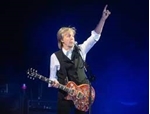
Paul McCartney has been writing songs since a young age. While growing up in Liverpool, he learned how to play the guitar, and the piano and later met the other band members who would form The Beatles. McCartney has had a music career that has lasted over six decades, and he has no plans to stop anytime soon. In an interview with Barnes & Noble’s James Daunt, Paul McCartney discussed his 2021 book The Lyrics: 1956 to the Present. The novel features analysis and backstories about 154 of McCartney’s songs he has written throughout his career. The former Beatle has worked hard to create this much music, but McCartney says he never saw it as work since it was what he loved doing. “I say to people when they say, ‘You work hard,’ I say, ‘Well, we don’t work music, we play it,’” McCartney explains. “And even though it might sound a bit glib, it is true. To me, it would be a hobby if I didn’t do it professionally. It’s just something I love because, you know, you’re creating this thing out of a black hole, and it’s very satisfying. So I love to do that.”
Source: Ross Tanenbaum/cheatsheet.com
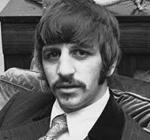
Ringo Starr said drummers could be replaced with gorillas and nobody would care. He said people treat drummers like second-class citizens. He wanted attention so much he was fine with negative reviews that at least mentioned him.
Ringo Starr said people didn’t view drummers as fully human. He said a gorilla could have replaced him and other drummers. Subsequently, he made it into the Rock & Roll Hall of Fame and several other drummers revealed their views of him.According to the 2015 book Ringo: With a Little Help, John Lennon and Paul McCartney spoke their minds in the studio during The Beatles’ early days. They would make it clear what they wanted their songs to sound like even when they were recording tracks written by other people. On the other hand, George Harrison and Ringo tended to be quiet and antisocial.
Source: Matthew Trzcinski/cheatsheet.com
details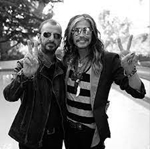
Ringo Starr rerecorded The Beatles‘ “Love Me Do” with a little help from Steven Tyler of Aerosmith. Subsequently, Tyler wrote about crossing paths with Ringo. The former initially wanted to change the song.
In his 2011 book Does the Noise in My Head Bother You?: A Rock ‘n’ Roll Memoir, Tyler discussed getting recruited to work on Ringo’s 1998 album Vertical Man. “Around that time, [producer] Marko Hudson was working on a Ringo album and put me on the phone with him — never mind the fact that it was the first time I’d ever spoken with Ringo, one of my heroes (an actual Beatle), and to say the least I was beside myself,” Tyler wrote.
Tyler was having difficulty with the other members of Aerosmith at the time. “I thought to myself, if I’m having problems with my bandmates and you’re in The Beatles, I can only imagine what you went through,” he recalled.
Source: Matthew Trzcinski/cheatsheet.com
details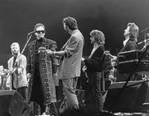
After George Harrison performed with Ringo Starr, Elton John, Jeff Lynne, and Eric Clapton at the Prince’s Trust Concert in 1987, many people thought they’d make a good band. With the idea “bubbling about,” George admitted he liked it.
George performed with his friends at the 1987 Prince’s Trust Concert. On Aspel & Co., George explained that before performing, it felt like he was going to the electric chair. Fortunately, George had Ringo, Clapton, Lynne, and Elton John to support him.
All four musicians also helped George record 1987’s Cloud Nine. Lynne co-produced the album, contributed vocals and various other instruments and co-wrote “That’s What It Takes,” “This Is Love,” and “When We Was Fab.” Ringo contributed drums on various tracks. Clapton added electric guitar on “Cloud 9,” “That’s What It Takes,” “Devil’s Radio,” and “Wreck of the Hesperus.” Meanwhile, Elton John contributed electric piano on “Cloud 9,” piano on “Devil’s Radio,” and “Wreck of the Hesperus.”
Source: Hannah Wigandt/cheatsheet.com
details
Mary McCartney, the daughter of The Beatles legend Paul McCartney, joined Good Day New York to address the constant death rumors involving her father.
Mary says one conspiracy theory involves the Abbey Road album cover, where Paul is seen being out of step with his bandmates and walking barefoot.
The theory states the white Volkswagen Beetle apparently has a number plate saying "28IF," suggesting Paul would have been 28 IF he had survived. Also, the four Beatles represent a funeral procession: George is the gravedigger, Paul is the corpse, Ringo is the congregation and John is the priest.
Source: FOX 5 NY
details